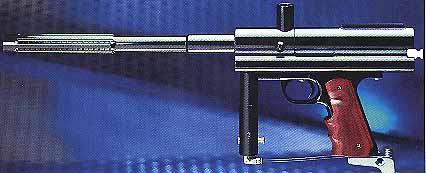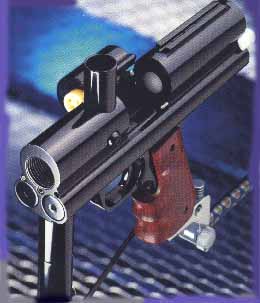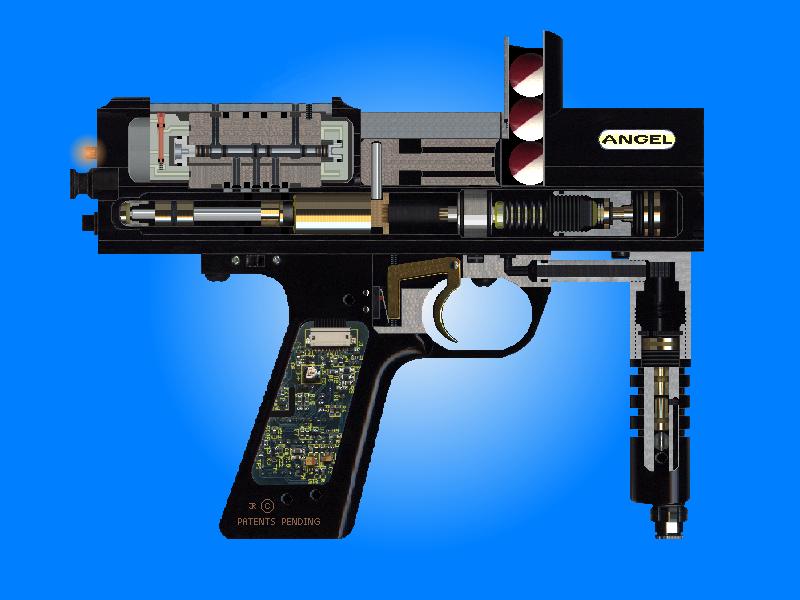
 |

MANUFACTURE- WDP
PROPELLANT- High Pressure Air(HPA) or Nitrogen
PRICE- MSRP is $1,200
 The Angel took the world by storm when it was first released. This is one of the most amazing paintball guns it can shoot 14+ balls a second, super short trigger pull, superb reliablity, and great looks. The Angel was he first electro-pnneumatic paintball gun to gain wide acceptance among players around the world. The Angels high price and short supply have made an object of wanting for those who want one and a staus symbol for those who own one.
The Angel took the world by storm when it was first released. This is one of the most amazing paintball guns it can shoot 14+ balls a second, super short trigger pull, superb reliablity, and great looks. The Angel was he first electro-pnneumatic paintball gun to gain wide acceptance among players around the world. The Angels high price and short supply have made an object of wanting for those who want one and a staus symbol for those who own one.
WDP created prefection when that made the Angel. This gun has everything a player could want or even dream of. The body is anodized stain black with some very stylish lines and curves. The gun itself features many standard features that are upgrades in most other guns. These include;
It is puzzling at first as to why a sight rail was built when the feed port is vertical and any line of sight would be obscured by the elbow. The Angel's creator John Rice says that the sight rail was there purely for aesthetics. It also serves to strengthen the construction of the main body which is really very solid. When the marker was being developed they weren't quite sure whether the market was ready for a vertical feed hopper and left the sight rail in the design in case they reverted to a left or right hand feed. The vertical feed proved successful as testing showed it could feed 1.6 paintballs more per second than other models.
The bolt is made of very lightweight industrial strength plastic (the plastic bolt reduces friction in the breech) called nyloil that is very readily removable from the gun by pulling a single knob and rotating it 90 degrees at the back of the gun, called Rotabreech, see picture, this is a really excellent feature that saves loads of
time when cleaning.
The Angel charges up from a cigarette lighter which plugs into the back of the gun. I was a bit worried about this at first because what happens in the middle of a game if you get a flat battery when you need it the most. Fortunately a full charge will give you 500,000 shots (a whopping 200 cases of paint) or 20,000 if you are using a VL2001 the add on extra hopper. An adapter to fit into a
home PowerPoint is readily available at an electronics store such as Dick Smith/Tandy/Radioshack. These deliver enough power to theoretically charge up 50 Angels at a time so would certainly do the business.
An adapter to fit into a
home PowerPoint is readily available at an electronics store such as Dick Smith/Tandy/Radioshack. These deliver enough power to theoretically charge up 50 Angels at a time so would certainly do the business.
The Angel comes in semi or full auto option which is changed via a chip beneath the
hand grip. Timing and velocity of fire can be adjusted on this chip to fire up to 15 shots a
second although it is factory set at between 10 and 12.
The Angels body is basicly three tubes stacked together. In the top tube is the opening for the barrel, the bolt and rota-breech, and finally the 14-way valve in the back. Below that and to the left is the battery tube. Opposite this tube is the one containing the Low Pressure Regulator(LPR), ram, hammer, and exhaust valve and guide. the 45 grip frame is screwed into the base of the three tubes, and holds the ciruit board, trigger, and battery isolator switch. Infront on the trigger frame connect by the vertical ASA adaptor is the Govnair regulator. The air line from your tank connects to the bottom of the regualtor. Now that you know where everything is lates see how it works.

The Angel is a open-bolt gun, not a close bolt blowback. The air form the regulator moves into the LPR. The LPR delivers air into the 14-way valve at a pressure of about 90psi(pounds per square inch), the 14-way valve is an electronic version of the 3-way valve on an autococker. The 14-way controls the gas flow to either side of the ram. When the trigger is pulled the ciruit board tells the 14-way valve to move the hammer and thus the bolt, which are contected by a pin, forward. The bolt forces a ball into the barrel and the hammer hits the exhaust valve opening it and releasing the air to fire the ball. The 14-way then switches back to return the hammer and bolt until the trigger is pulled again. There is a brief pause after the hammer hits the exhaust valve, called the "Dwell", this pause determines how much air from the exhaust valve hits the ball. The Dwell can be changed by setting a switch on the ciruit board. The cycle of this gun is not very complex.
This will be a very short section, because the Angel requires little maintance. In The Angel operation manual it says to wip clean with a damp cloth and oil the external moving parts. I also suggest putting a few drops into LPR to keep the o rings inside the gun from drying out.
Please feel free to email me if you find any broken links or if you have any suggestions regarding the Links on this page and I will attempt to verify and correct the information within the week.